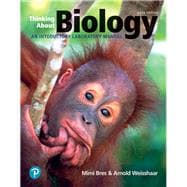For one-semester, non-majors introductory biology laboratory courses
Thinking About Biology: An Introductory Lab Manual offers an extensively class-tested approach to the introductory biology laboratory course. The manual enables students to see how scientists work to solve problems through scientific investigation by asking questions and answering them through observations and conducting experiments. This lab manual helps students gain practical experience to better understand lecture concepts, acquire the basic knowledge needed to make informed decisions about biological questions in everyday life, develop the problem-solving skills that will lead to success in school and a competitive job market, and learn to work effectively and productively as a member of a team.
The 6th Edition features new and revised activities based on feedback from students and faculty.










